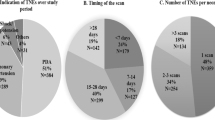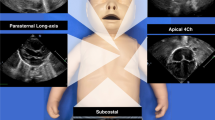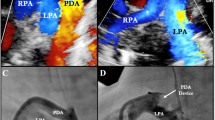Abstract
Background
The aim of this study was to assess whether neonatologist-performed echocardiography (NPE) changed the previously planned hemodynamic approach in critically ill newborn infants.
Methods
This prospective cross-sectional study included the first NPE of 199 neonates. Before the exam, the clinical team was asked about the planned hemodynamic approach and the answer was classified as an intention to change or not to change the therapy. After being informed about the NPE results, the clinical management was grouped as performed as previously planned (maintained) or modified.
Results
NPE modified the planned pre-exam approach in 80 cases (40.2%; 95% CI: 33.3–47.4%), and variables associated with an increased chance of this modification were exams to assess pulmonary hemodynamics (prevalent ratio (PR): 1.75; 95% CI: 1.02–3.00) and to assess systemic flow (PR: 1.68; 95% CI: 1.06–2.68) in relation to those requested for patent ductus arteriosus, pre-exam intention of changing the prescribed management (PR: 2.16; 95% CI: 1.50–3.11), use of catecholamines (PR: 1.68; 95% CI: 1.24–2.28) and birthweight (per kg) (PR: 0.81; 95% CI: 0.68–0.98).
Conclusion
The NPE was an important tool to direct hemodynamic management in a different approach from the previous intention of the clinical team, mainly for critically ill neonates.
Impact
-
This study shows that neonatologist-performed echocardiography guides the therapeutic planning in the NICU, mainly in the more unstable newborns, with lower birthweight and receiving catecholamines.
-
Exams requested with the intention of modifying the current approach were more likely to change the management in a different way than planned pre-exam.
This is a preview of subscription content, access via your institution
Access options
Subscribe to this journal
Receive 14 print issues and online access
$259.00 per year
only $18.50 per issue
Buy this article
- Purchase on Springer Link
- Instant access to full article PDF
Prices may be subject to local taxes which are calculated during checkout
Similar content being viewed by others
Data availability
The complete database is available on request with the corresponding author.
References
Kluckow, M., Seri, I. & Evans, N. Functional echocardiography: an emerging clinical tool for the neonatologist. J. Pediatr. 150, 125–130 (2007).
El-Khuffash, A. F. & McNamara, P. J. Neonatologist-performed functional echocardiography in the neonatal intensive care unit. Semin. Fetal Neonatal Med. 16, 50–60 (2011).
Tissot, C. & Singh, Y. Neonatal functional echocardiography. Curr. Opin. Pediatr. 32, 235–244 (2020).
Barrington, K., El-Khuffash, A. & Dempsey, E. Intervention and outcome for neonatal hypotension. Clin. Perinatol. 47, 563–574 (2020).
Osborn, D. A., Evans, N. & Kluckow, M. Clinical detection of low upper body blood flow in very premature infants using blood pressure, capillary refill time, and central-peripheral temperature difference. Arch. Dis. Child Fetal Neonatal Ed. 89, F168–F173 (2004).
Kluckow, M. Use of ultrasound in the haemodynamic assessment of the sick neonate. Arch. Dis. Child Fetal Neonatal Ed. 99, F332–F337 (2014).
de Boode, W. P. et al. The role of neonatologist performed echocardiography in the assessment and management of neonatal shock. Pediatr. Res. 84, 57–67 (2018).
Moss, S. et al. Evaluation of echocardiography on the neonatal unit. Arch. Dis. Child Fetal Neonatal Ed. 88, F287–F289 (2003).
El-Khuffash, A. et al. Targeted neonatal echocardiography (TnECHO) service in a Canadian neonatal intensive care unit: a 4-year experience. J. Perinatol. 33, 687–690 (2013).
Corredera, A. et al. Functional echocardiography in neonatal intensive care: 1 year experience in a unit in Spain. An. Pediatr. (Barc.) 81, 167–173 (2014).
Harabor, A. & Soraisham, A. S. Utility of targeted neonatal echocardiography in the management of neonatal illness. J. Ultrasound Med. 34, 1259–1263 (2015).
Khamkar, A. M. et al. Functional neonatal echocardiography: Indian experience. J. Clin. Diagn. Res. 9, SC11–SC14 (2015).
Papadhima, I. et al. Targeted neonatal echocardiography (TNE) consult service in a large tertiary perinatal center in Canada. J. Perinatol. 38, 1039–1045 (2018).
Alammary, D., Narvey, M., Soni, R., Elsayed, Y. & Louis, D. Targeted neonatal echocardiography service in neonatal intensive care in Manitoba, Canada. J. Perinatol. 42, 655–659 (2021).
Mertens, L. et al. Targeted Neonatal Echocardiography in the Neonatal Intensive Care Unit: practice guidelines and recommendations for training. Writing Group of the American Society of Echocardiography (ASE) in collaboration with the European Association of Echocardiography (EAE) and the Association for European Pediatric Cardiologists (AEPC). J. Am. Soc. Echocardiogr. 24, 1057–1078 (2011).
Groves, A. M. et al. Introduction to neonatologist-performed echocardiography. Pediatr. Res. 84, 1–12 (2018).
van Laere, D. et al. Application of NPE in the assessment of a patent ductus arteriosus. Pediatr. Res. 84, 46–56 (2018).
de Boode, W. P. et al. Application of neonatologist performed echocardiography in the assessment and management of persistent pulmonary hypertension of the newborn. Pediatr. Res. 84, 68–77 (2018).
Hillman, L. S. et al. Poorer outcomes of all low birth weight groups at age 10: Missouri statewide case-control study. Early Hum. Dev. 136, 60–69 (2019).
Fanaroff, A. A. et al. Trends in neonatal morbidity and mortality for very low birthweight infants. Am. J. Obstet. Gynecol. 196, 147.e1–147.e8 (2007).
Stranak, Z. et al. International survey on diagnosis and management of hypotension in extremely preterm babies. Eur. J. Pediatr. 173, 793–798 (2014).
Batton, B. et al. Early blood pressure, antihypotensive therapy and outcomes at 18-22 months’ corrected age in extremely preterm infants. Arch. Dis. Child Fetal Neonatal Ed. 101, F201–F206 (2016).
Belletti, A. et al. Vasoactive-inotropic score: evolution, clinical utility, and pitfalls. J. Cardiothorac. Vasc. Anesth. 35, 3067–3077 (2021).
Aziz, K. B. et al. Maximum vasoactive-inotropic score and mortality in extremely premature, extremely low birth weight infants. J. Perinatol. 41, 2337–2344 (2021).
Author information
Authors and Affiliations
Contributions
S.d.A.N.F. has participated in the concept and design; collection of data; analysis and interpretation of data; drafting and revising the manuscript. A.S. has participated in design; statistical analysis and interpretation of data; drafting and revising the manuscript. A.C.d.O. and R.G. have participated in the concept and design; analysis and interpretation of data; drafting and revising the manuscript. M.M.Z., C.M. and M.H.M. participated in the design of the study, interpretation of data, and revising the manuscript.
Corresponding author
Ethics declarations
Competing interests
The authors declare no competing interests.
Ethics approval
The research protocol was approved by the Ethics Committee Universidade Federal de São Paulo – Unifesp (approval number 2,083,829).
Consent for publication
This manuscript is being submitted only to Pediatric Research and it will not be submitted elsewhere while under consideration. All authors listed on the manuscript approved the submission of this version of the manuscript and take full responsibility for the manuscript.
Additional information
Publisher’s note Springer Nature remains neutral with regard to jurisdictional claims in published maps and institutional affiliations.
Supplementary information
Rights and permissions
Springer Nature or its licensor (e.g. a society or other partner) holds exclusive rights to this article under a publishing agreement with the author(s) or other rightsholder(s); author self-archiving of the accepted manuscript version of this article is solely governed by the terms of such publishing agreement and applicable law.
About this article
Cite this article
Negreiros Figueira, S.d.A., de Oliveira, A.C., Zamith, M.M. et al. Echocardiography performed by the neonatologist: the impact on the clinical management. Pediatr Res 94, 724–729 (2023). https://doi.org/10.1038/s41390-023-02526-0
Received:
Revised:
Accepted:
Published:
Issue Date:
DOI: https://doi.org/10.1038/s41390-023-02526-0



